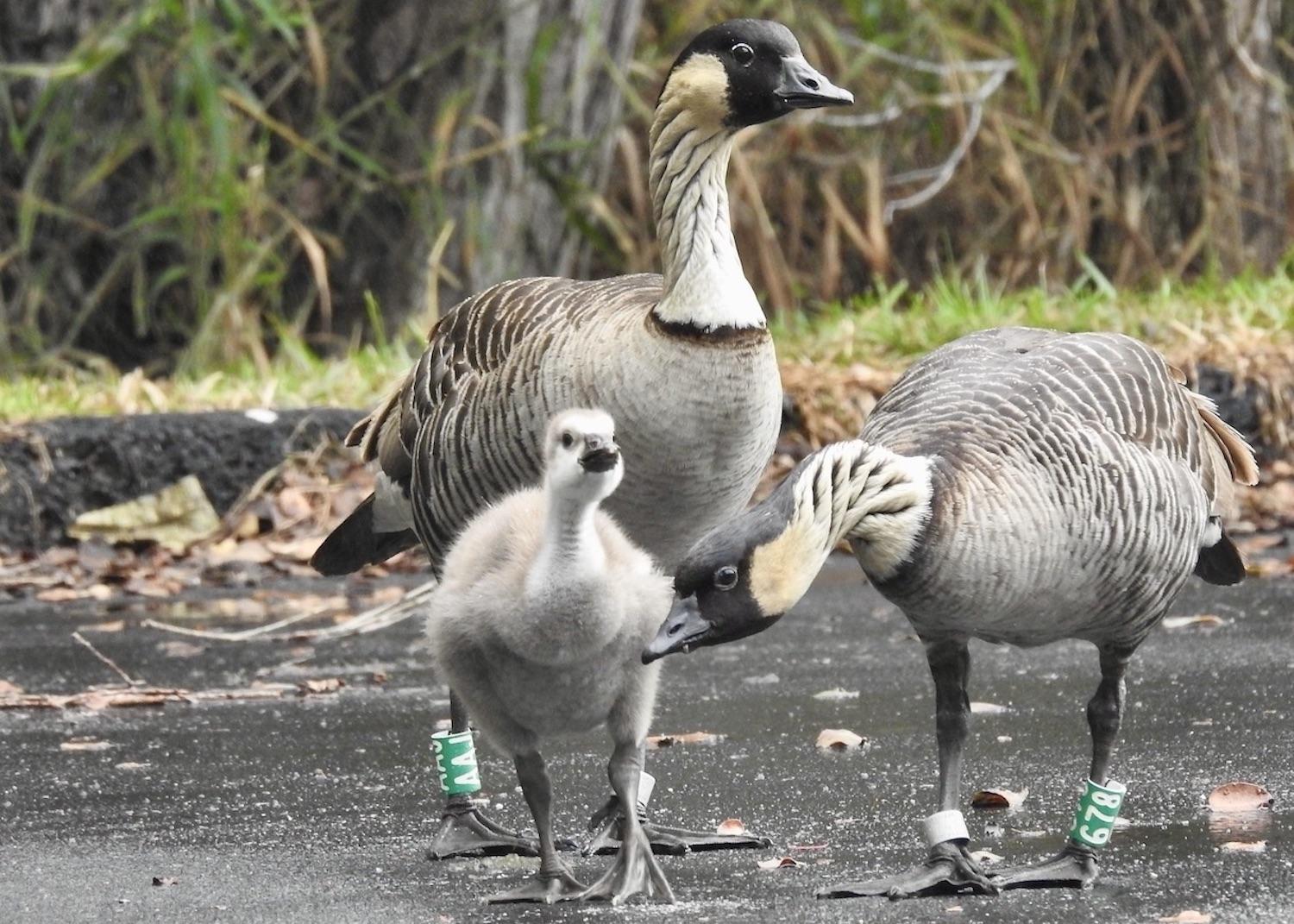
Three members of a nēnē family wander in the parking lot by Devastation Trail in February 2023/Jennifer Bain
For four days, I drove in careful but determined circles around Hawaiʻi Volcanoes National Park scouring roadsides, parking lots and lawns looking for the world’s rarest goose.
I saw two of the threatened state birds flying over the Kīlauea Visitor Center apparently on their way to the Volcano Golf Course, and feared that was as close as I would get to the fabled nēnē. But then coming off the Devastation Trail on foot in the last moments of my visit, I finally chanced upon a family of four blithely foraging in the parking lot.
The mom, I learned later, is 15 years old and called 678. Her much younger partner, AAJ, is nine but also old enough to know the risks of getting hit by a car or becoming acclimatized to humans and their handouts.
On that day in early February, as people packed the park for a chance to see the Kīlauea volcano eruption, the nēnē had just two goslings with them. Three had been born Dec. 28, but one soon disappeared. It was probably the victim of predation.
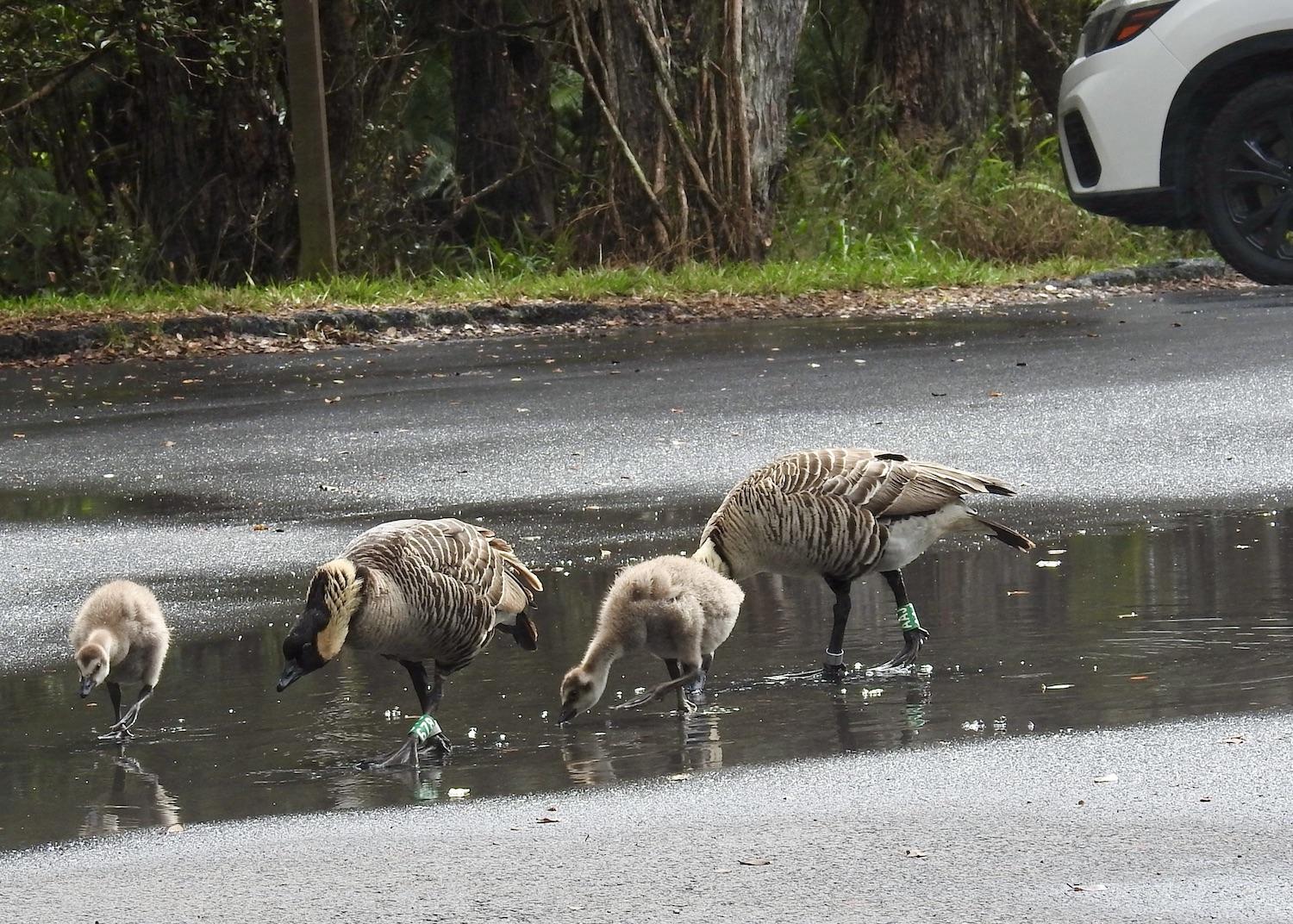
This nēnē family wanders a parking lot in Hawai'i Volcanoes National Park in February during a summit eruption/Jennifer Bain
“These are the two that have been nesting here,” said a delighted Paul Field, project leader of the volunteer Stewardship at the Summit program that I had just taken part in. “Pictures are okay,” he added as I plunked myself down at the edge of the parking lot and pulled out my superzoom.
But he was troubled by two excited women interacting with the nēnē — following them as they searched for food and splashed in rain puddles on the asphalt — and so he gently reminded them to keep their distance.
“We just got out of the car and they were here — they’re following us,” the women said defensively.
“Oh well, yeah, the parents always hang out in the parking lot and people aren’t supposed to feed them but they do,” Field calmly replied. The women assured him they knew better than to do that.
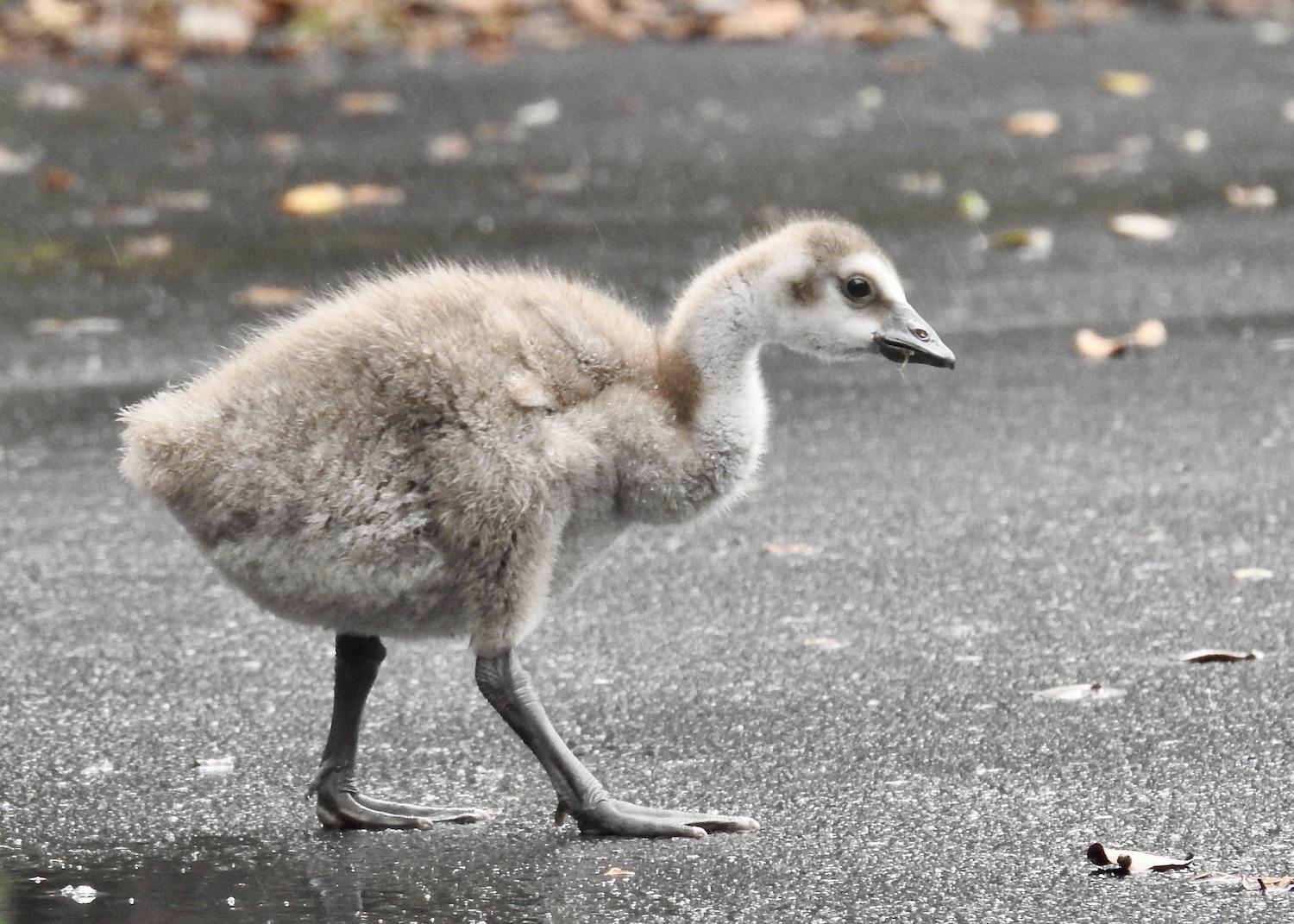
This nēnē gosling is already learning not to fear humans and to approach them for food/Jennifer Bain
When Field’s wife Jane came off the trail minutes later, she too voiced her dismay. “Don’t let them follow you if you can help it,” she warned the women. “We really don’t want them in the parking lot. Unfortunately, if they learn anything from their parents, they’re going to beg for food.”
As I sat taking photos — mindful that you are supposed to stay 60 feet away from this protected species — the curious nēnē came within arm’s reach. I should have backed away from the fearless goslings but sat frozen. The parents gave me imploring looks but stopped short of snapping like their belligerent Canada Geese relatives do back in Toronto when I refuse to provide food.
“I think the nēnē is perhaps the most beautiful goose,” Jane told me. “These have such have beautiful faces.”
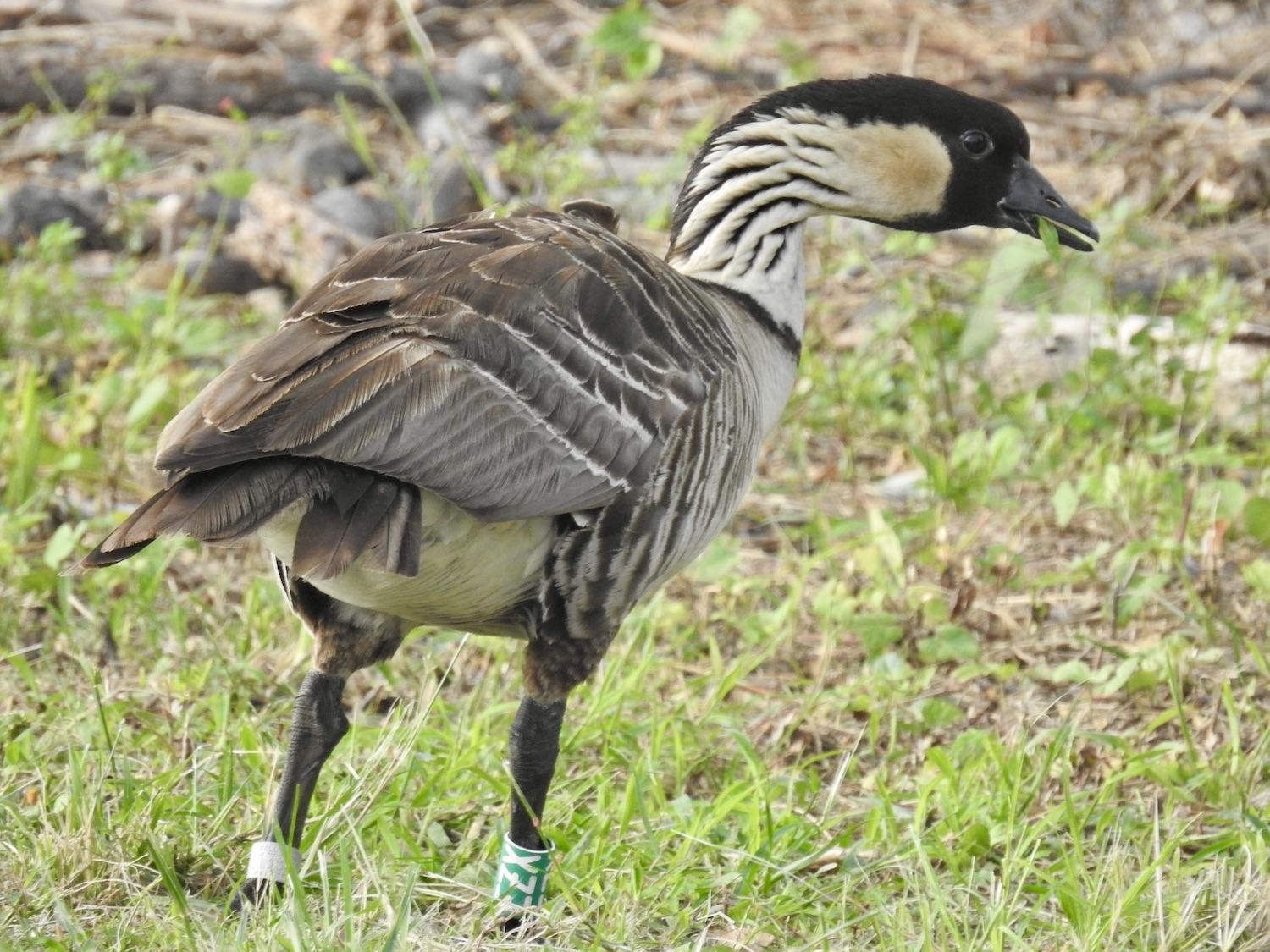
Just outside of Hawai'i Volcanoes National Park, driving between the main park and its Kahuku Unit, I spotted this nēnē on the road to Punaluʻu Black Sand Beach/Jennifer Bain
Named for its soft, gentle call, the nēnē (Branta sandvicensis) is a species of goose endemic to the Hawaiian Islands. It’s the state’s official bird and largest native land animal. Unlike the Canada Goose, its neck isn’t solid black, but is deeply furrowed and buff-colored with matching cheek patches. It has strong feet, padded toes, and reduced webbing, presumably because it’s less aquatic here and has adapted to a life spent walking across lava rock landscapes.
As I continued to take photos, I was reminded of a magazine article called “The Wordly Bird” that was tucked into a welcome binder in my room at the Kīlauea Lodge & Restaurant. Writer Julia Porter Steele was right when she said these understated, even drab, geese “are profoundly graceful and radiate a calm not seen in other birds. They are, in a word, dignified.”
Dignified — even though they’re under threat. An estimated 25,000 nēnē existed in Hawaiʻi when Captain Cook arrived in 1778. By 1952, only about 30 birds remained. Nēnē were listed as endangered in 1967 and then, thanks to captive breeding and other conservation efforts, reclassified as threatened in 2020. Their numbers are now holding steady.
For more on the state of the nēnē, I questioned the park’s natural resources program manager, Sierra McDaniel, and Charlotte Forbes-Perry, the lead field biologist for the park’s nēnē recovery program. Forbes-Perry is with the University of Hawaiʻi, which operates under a cooperative ecosystems study unit with the park. She has worked alongside National Park Service biologists for more than a decade.
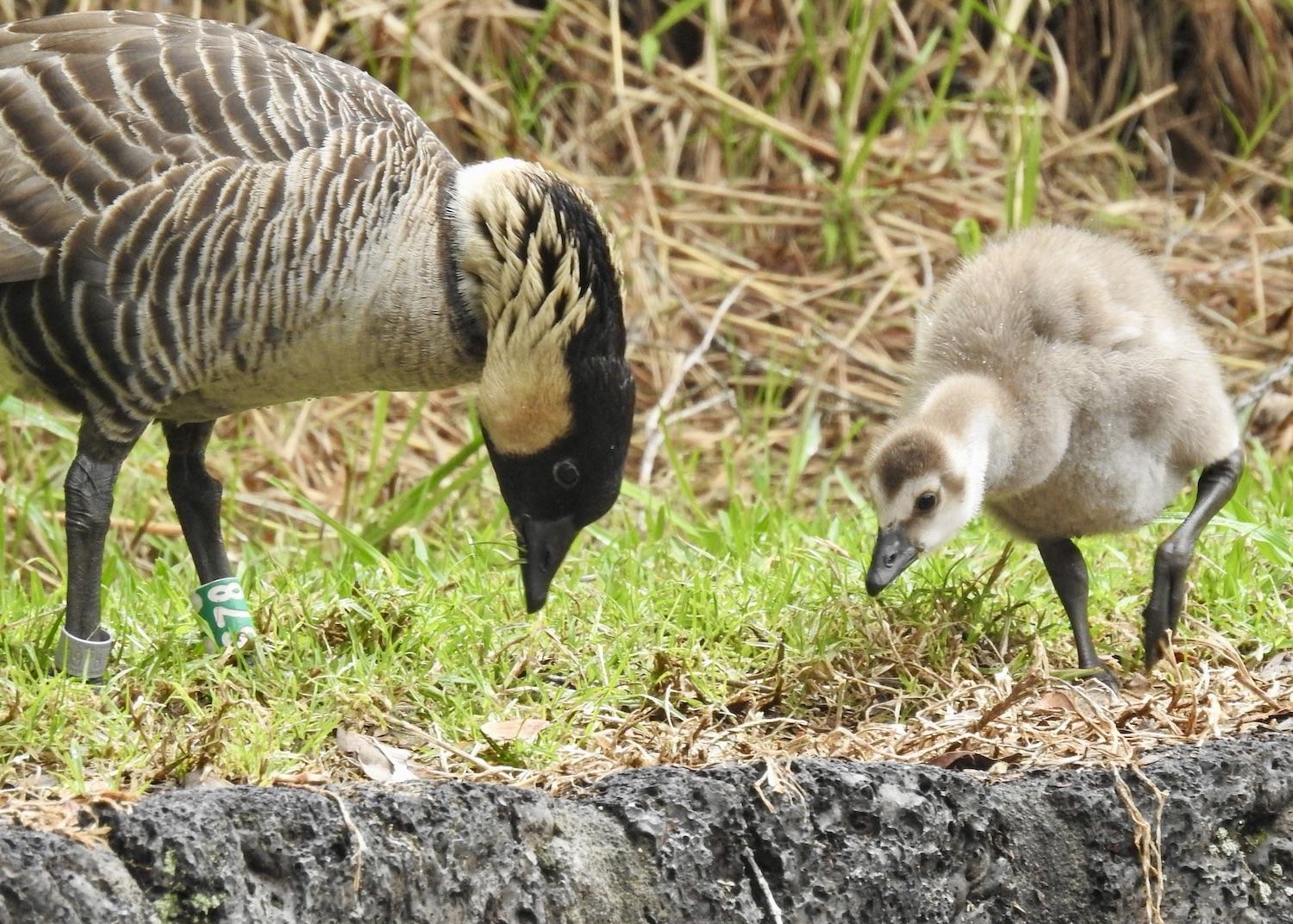
Nēnē 678 teaches her gosling to forage in the parking lot by Devastation Trail/Jennifer Bain
The Nēnē Recovery Action Group counted 3,864 nēnē in the state in 2021. That included 2,430 on Kauaʻi, 1,074 on the island of Hawaiʻi, 354 on Maui and just six on Molokaʻi. I was most interested in the 182 nēnē found here in Hawaiʻi Volcanoes, but kept an eye out for the geese as I drove in loops around the island for a week.
In the 1970s, park staff and conservation partners began a captive nēnē breeding and reintroduction program. In the 1980s, it shifted from breeding and releasing birds to improving their habitat, reducing predators and monitoring wild nests. Predators (mongoose, feral cats, rats, dogs and pigs) kill adults and goslings. Vehicles hit and kill nēnē along roadways. Errant golf balls injure and kill nēnē that are drawn to the grassy fairways of golf courses. Drought impacts available food and goslings don’t always get the high protein forage they need. Old age and disease kill some of the herbivores.
Population dynamics in the park are monitored, and the number of deaths varies from year to year. But only a few deaths can be documented and those are usually the vehicle strikes.
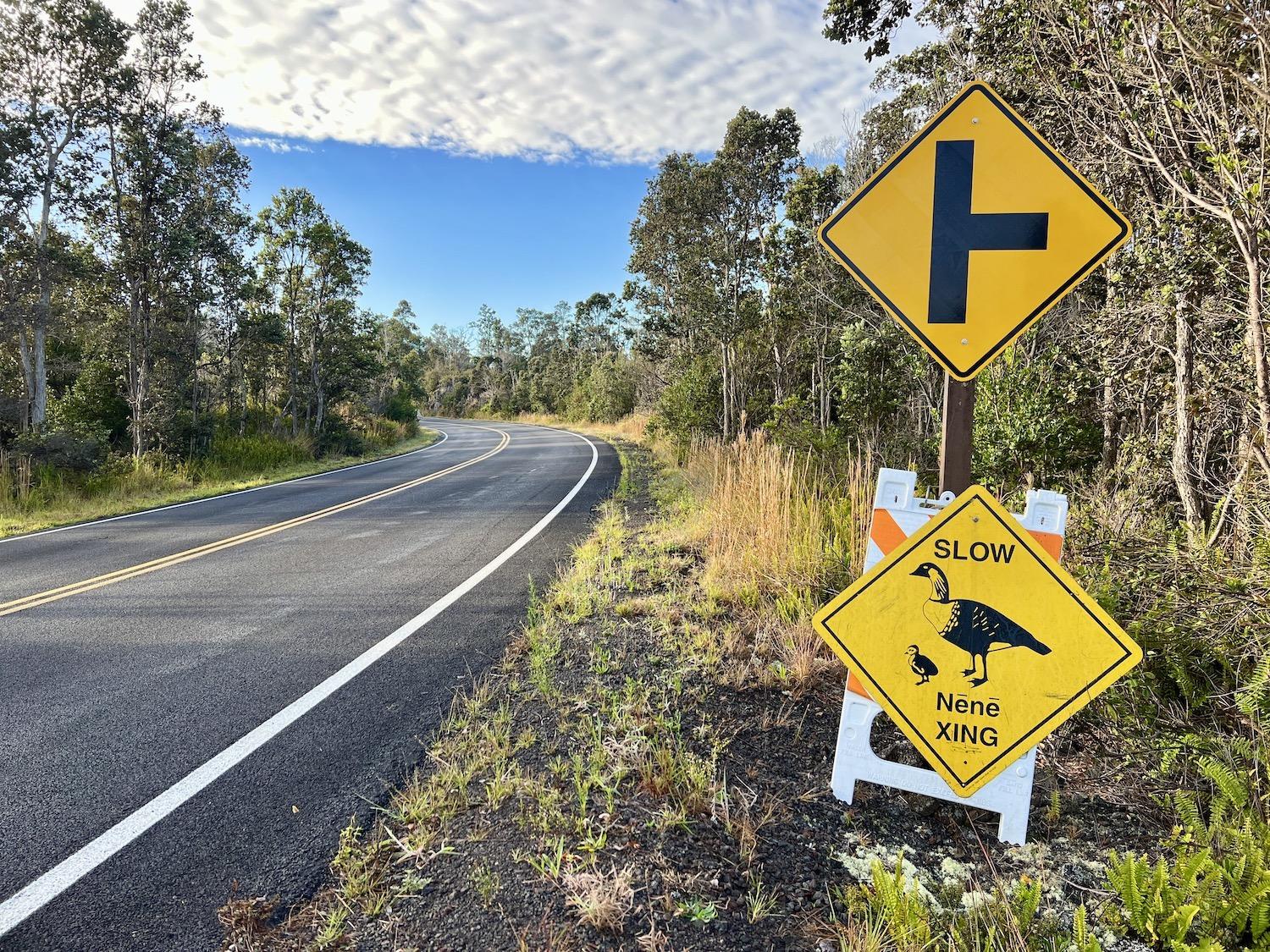
A variety of signs to protect nēnē can be found in Hawai‘i Volcanoes National Park/Jennifer Bain
As I drove around the park those four days, I saw a dizzying array of yellow warning signs telling me how to protect nēnē.
“Slow,” screamed one message along Chain of Craters Road with a sketch of a gosling and its mom. “Nēnē XING.”
Under a sketch of an adult goose, other roadside warnings specified “NEXT 5 MILES” and sometimes “25 MPH.”
“Do Not Feed Nēnē,” implored the most common sign. “Keep Them Wild.” That sign had a nēnē and an outstretched hand holding food inside a red circle with a slash through it.
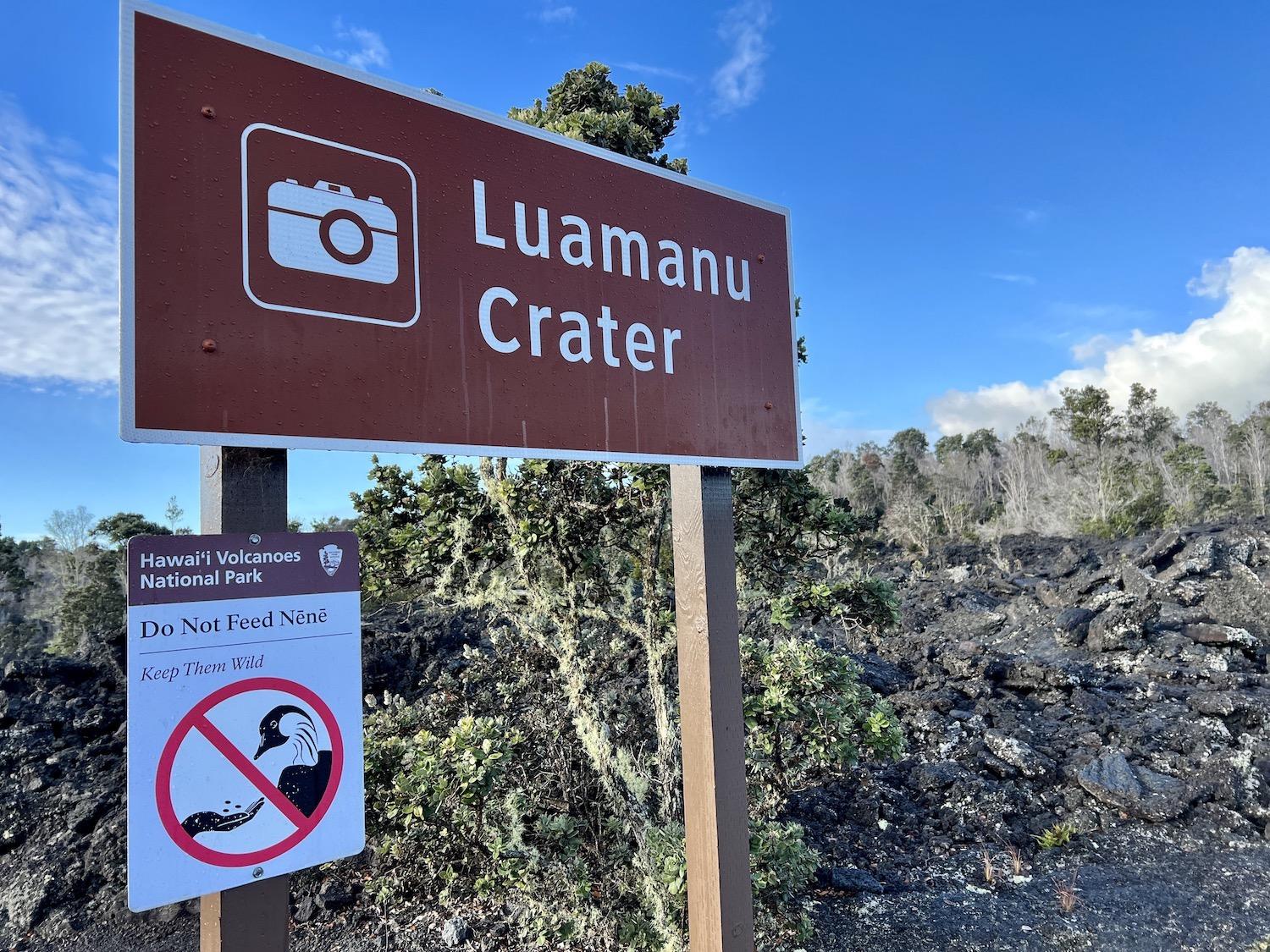
More park signage to protect nēnē, whose webbed feet have evolved to walk across lava rock landscapes/Jennifer Bain
On a busy footpath to a hotspot for eruption viewing, a “do not approach nēnē” sign showed geese with a speech bubble saying “distance makes the heart grow fonder.” It depicted four cars for visual learners and said “60 ft/18 m, about four car-lengths for nēnē, a federally protected species.”
In the parking lot where I met 678 and AAJ’s family, a sign attached to a sandwich board said “DO NOT APPROACH NĒNĒ” in bold, uppercase letters, and “stay four car-lengths away” in lowercase letters. On it, two nēnē stare at a mother holding hands with her child. There was a red slash over the humans.
I saw two feral pigs, one feral cat, and infinitely more nēnē signs than nēnē and wondered about all the messaging nuances. There are actually eight road-based nēnē signs in the park and on the highway that goes through it. Additional signs are placed at trailheads and parking lots. Temporary signs are deployed as needed for closures. The signs provide messages specific to issues at each location.
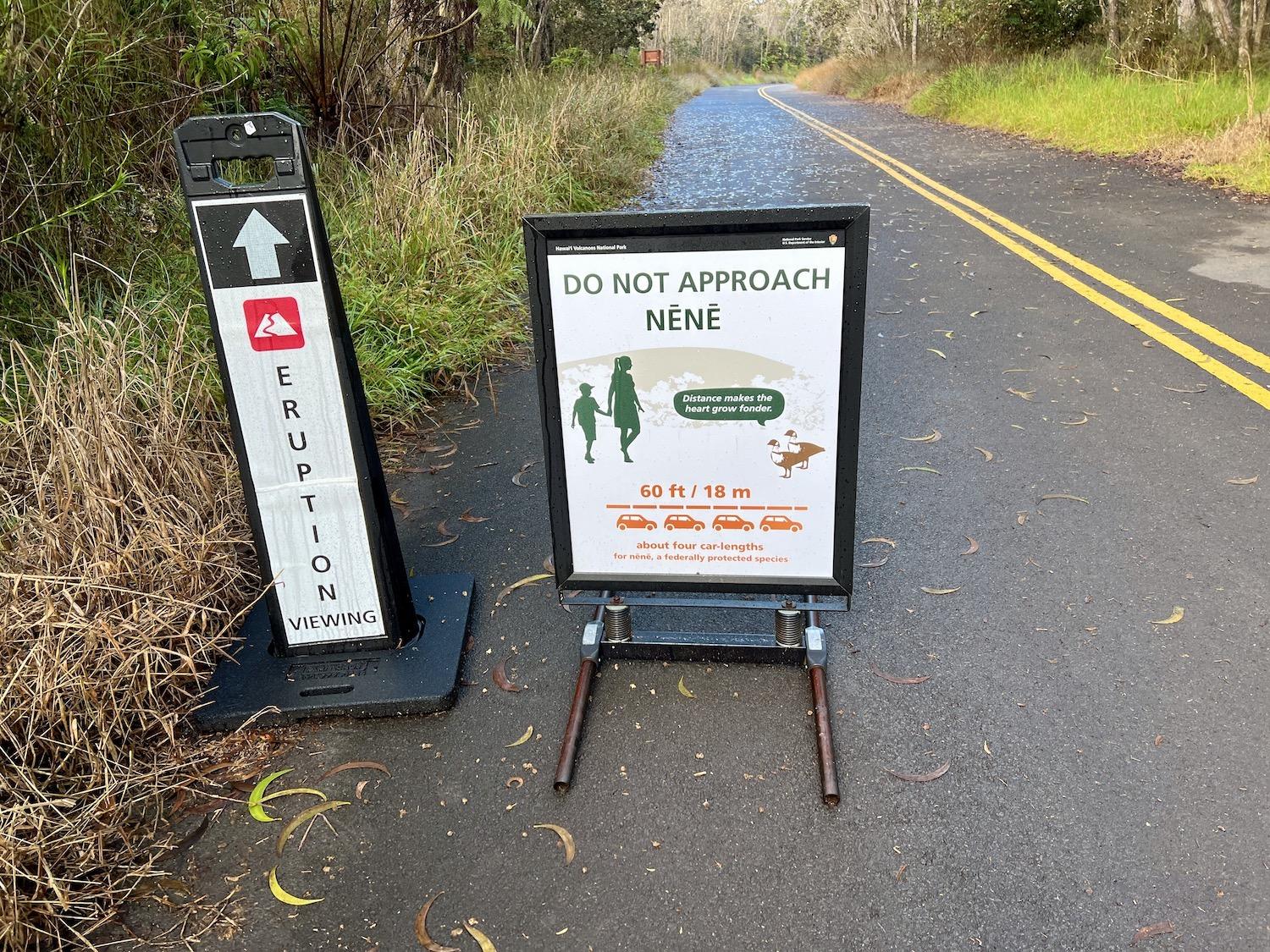
When people feed wild birds, like nēnē, they put their health and futures at risk/Jennifer Bain
Watch the 38-second public service announcement video on the park website and you'll find two numbers to call if you see nēnē on the road in the park or outside the park. One goes to park dispatch, which will notify wildlife biologists about injured birds or nēnē in the roadway. The other goes to the State of Hawaiʻi Division of Forestry & Wildlife for nēnē emergencies outside the park.
People do call, Forbes-Perry and McDaniel said. They're generally excited to see nēnē and have a positive view of them. The small population is nowhere near the large numbers of migratory Canada Geese that make a nuisance of themselves in Canada and mainland U.S.A. Nēnē don’t create scads of unpleasant droppings in parks like their loathed cousins do, and they’re smaller and less aggressive — unless protecting their young, of course.
“The birds are endemic to Hawaiʻi and they should be able to flourish here,” the women said. “They are the last of the original six species of geese that existed in Hawaiʻi and are considered the rarest goose in the world. They are also important elements of the ecosystem dispersing seeds of native plants such as ʻōhelo. They are part of our biocultural heritage and are included as a kiaʻi (guardian) in the Kumulipo (Native Hawaiian Creation chant).”
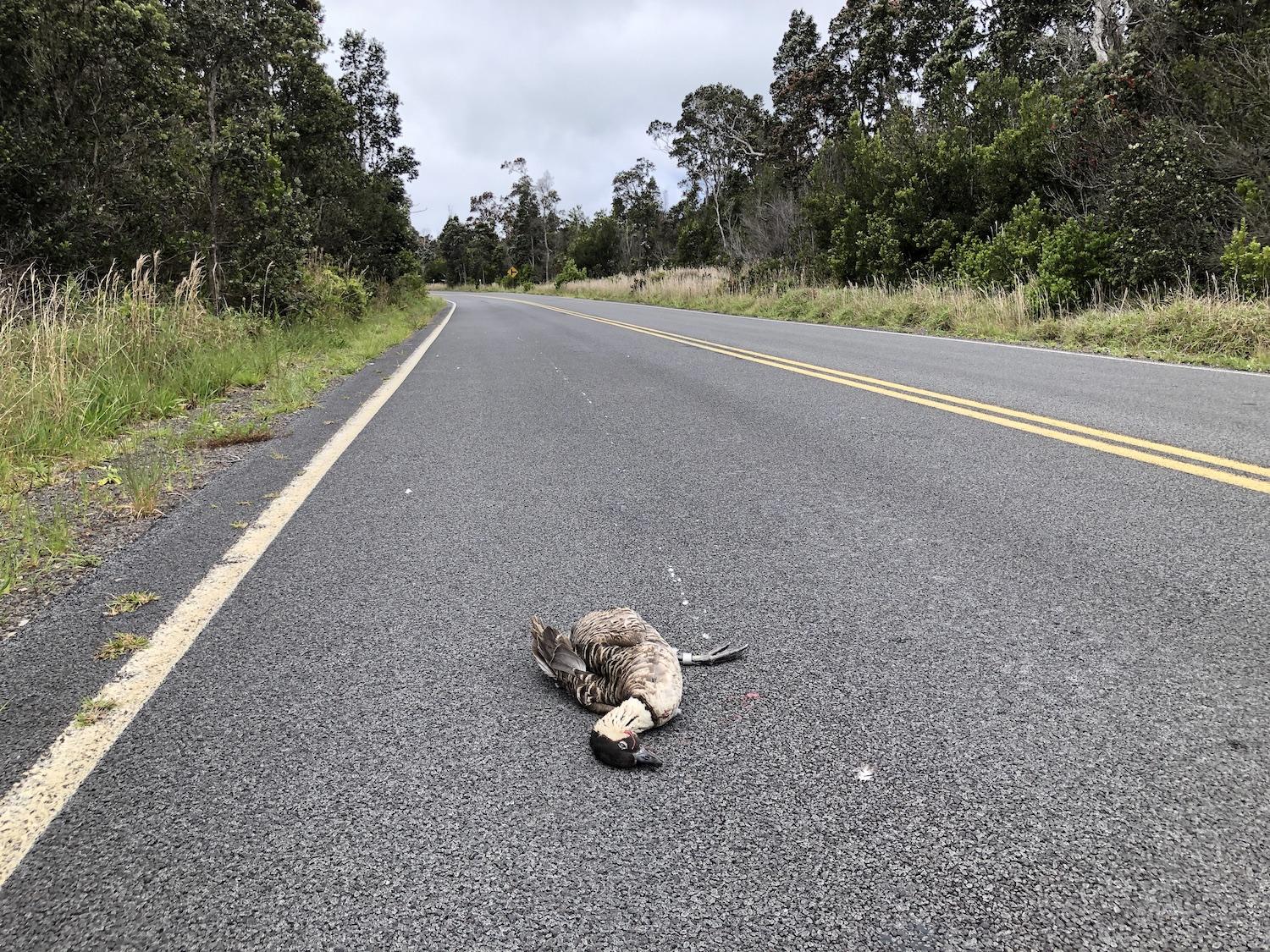
A 2019 file shot from Hawai'i Volcanoes National Park shows a nēnē that has been killed by a vehicle/NPS Photo, J. Wei
When park rangers and biologists see visitors feeding the geese or getting too close to them, they will — like the Fields — gently explain why these actions are bad for the birds and their survival. Visitors are rarely cited for feeding nēnē, but it did happen in 2013 and 2022 and carries a $100 fine with a $30 processing fee.
No one has been charged with killing nēnē in the park and all recent deaths have involved motor vehicles. The park does issue news releases for "speeding and feeding" deaths, like the distressing time in October 2021 when three nēnē were struck on Chain of Craters Road.
Superintendent Rhonda Loh was quoted back then as saying it was “tragic that three rare nēnē are dead because of speeding or inattentive motorists in the park, especially a mated pair at the start of breeding and nesting season. We need everyone to slow down, watch out for wildlife and understand that the park is their habitat. It is also imperative that people never feed nēnē. Besides being unhealthy for the birds, feeding wildlife gets them comfortable around humans and vehicles, which all too often has a fatal outcome.”
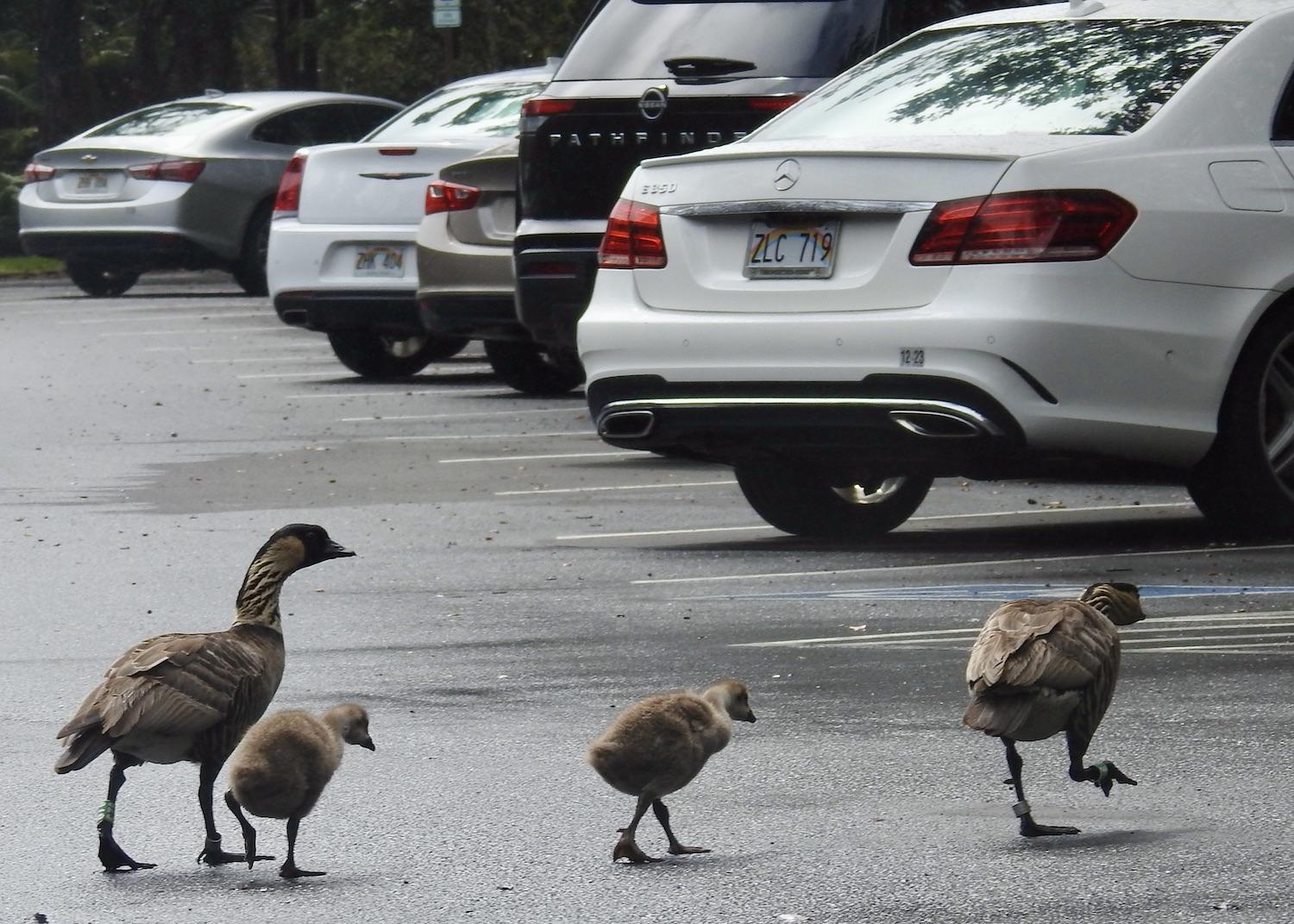
When nēnē start frequenting parking lots at Hawai'i Volcanoes, the area might be temporarily closed/Jennifer Bain
I went to Hawai'i Volcanoes National Park for the dramatic eruption viewing, but quickly became transfixed by the more subtle nēnē story.
As I drove Crater Rim Drive and Chain of Craters Road, from Uēkahuna (the summit region of Kīlauea volcano) down to the Hōlei Sea Arch, I experienced open stretches flanked by lava fields and forests full of winding curves. Speed limits, speed humps, and nēnē warning signs kept me in check, but I still feared rounding a corner and hitting a goose.
When I stopped into the park's visitor center to chat with rangers and read the interpretation displays, I was more interested in learning about nēnē than volcanoes.
Nēnē are descended from a lost pair of Canada Geese and evolved into non-migratory birds with short wings and reduced webbing in their feet to walk on lava. The best time to spot nēnē is reportedly in the early morning or at dusk as they travel in pair or small groups between nighttime roosts and daytime feeding areas where they forage for grasses, seeds, and berries (although that guidance didn't work for me).
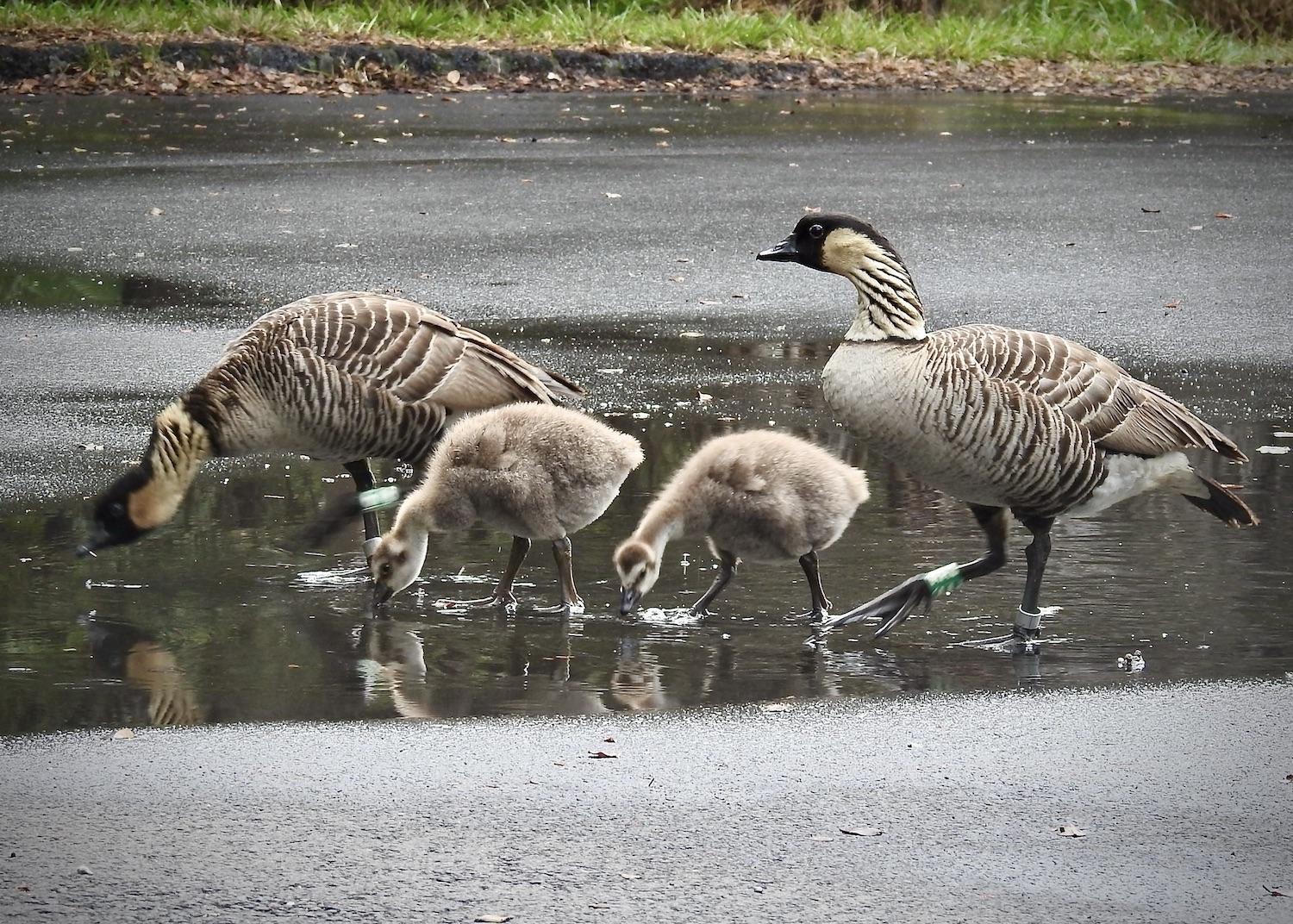
Nēnē typically mate for life, and their webbed feet are different from their cousins because they spend more time on lava rock than in the water/Jennifer Bain
Nēnē usually mate for life and raise goslings together. The October through April breeding/nesting season is crucial for their survival, but it's also when they’re the most vulnerable to being run over as they focus on eating.
The nest of nēnē 678, I learned, was on the ground near Keanakākoʻi Crater in the same spot she and AAJ picked in the 2021-2022 nesting season. A wildlife camera placed near the nest monitored the family and that’s how the park knew exactly when the three goslings hatched just after Christmas.
The family started to frequent a closed portion of Old Crater Rim Drive near Keanakākoʻi. Then the geese traveled to the Puʻupuaʻi parking area where 678 and AAJ had successfully raised a fledgling in 2019. On January 6, the park closed this parking area to protect the family by reducing interaction with visitors. The nēnē family began using this area as its home base, but one of its goslings went missing three weeks later.
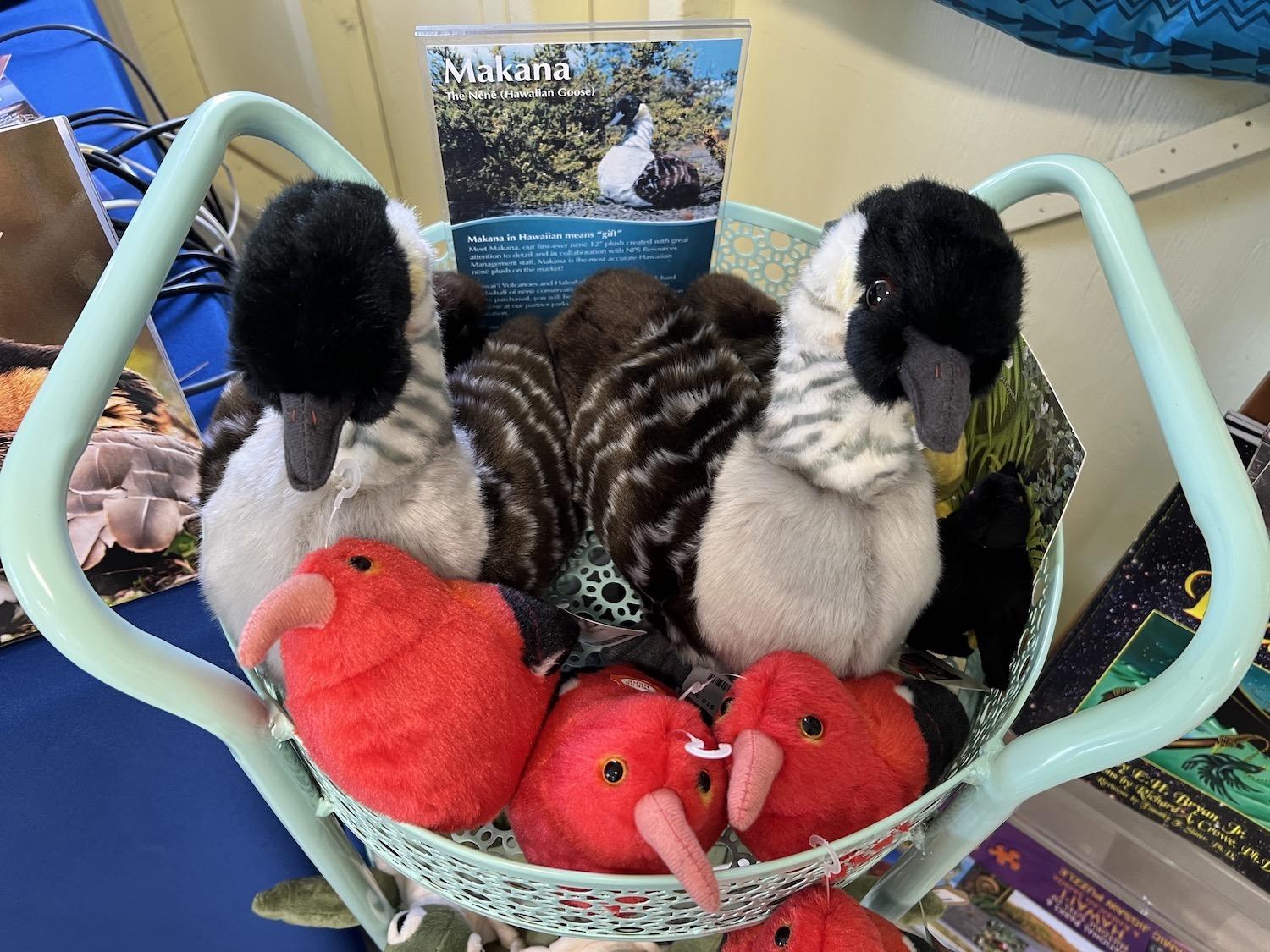
$1 from the sale of each plush nēnē — spotted here in the Kahuku Unit's gift shop — goes to conservation projects/Jennifer Bain
As I grew frustrated about reading about nēnē without ever seeing them, I drove to the park's Kahuku Unit, an hour away.
On a quick detour off Highway 11 to see Punaluʻu Black Sand Beach, I finally saw three nēnē eating alongside the road — but I still yearned to see some in the park. There are nēnē at the Kahuku Unit, but only in upper areas that have been closed to visitors. The unit's gift shop does sell a plush nēnē named Makana (“gift") that was created by the Hawai‘i Pacific Parks Association in collaboration with partners at Hawaiʻi Volcanoes and Haleakalā National Park. For every sale, $1 goes to conservation efforts.
It has taken generations of people working together to recover the nēnē, and the rare goose will probably always need our help.
As Forbes-Perry and McDaniel later told me, the park’s breeding and reintroduction program evolved to help nēnē survive. Predators (feral cats, mongoose, rats and pigs) are trapped near nesting and brooding areas during breeding season. Pastures are mowed around every six weeks to promote new grass growth. Closed to the public, the park’s ʻAinahou Ranch is home to a cat-proof and mongoose-proof exclosure constructed in 1994 and upgraded over the years. Within the unit, invasive plants are removed and the grass is mowed to enhance the habitat. Since construction, dozens of birds have fledged from this protected area.
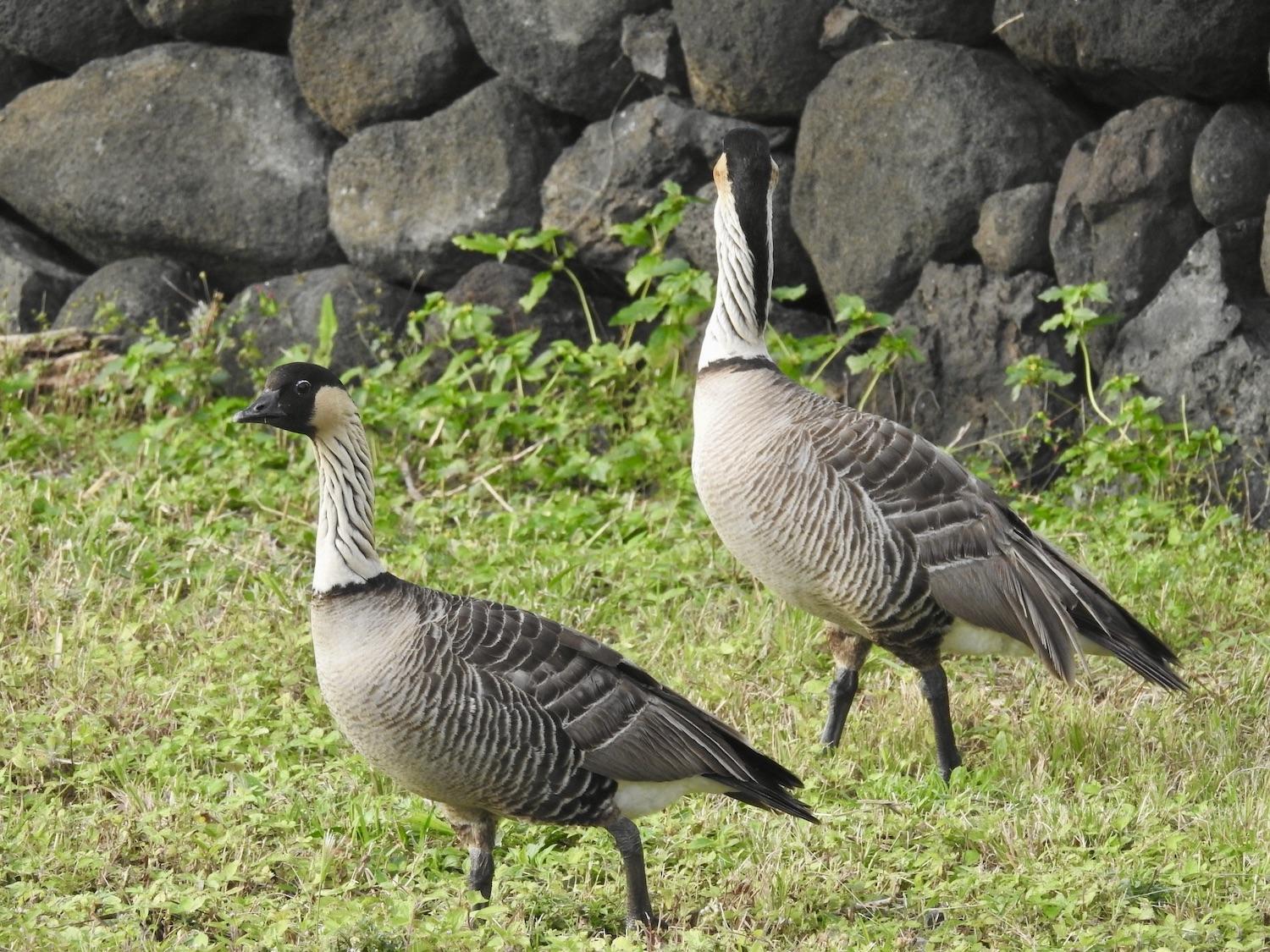
On the road to Punaluʻu Black Sand Beach, just outside Hawai'i Volcanoes National Park, I got a good look at the gorgeous necks of these two nēnē/Jennifer Bain
Back in the main area of the park, nēnē have nested near the former Jaggar Museum at Uēkahuna and the Devastation parking lot. They have brought their families into the parking lots that are packed during Kīlauea summit eruptions. The park sometimes closes these spots until nēnē families leave the area.
On top of all these daunting human and animal threats, Forbes-Perry and McDaniel have seen climate change impact the geese. “Over the last 100 years drought events have become more frequent and severe,” they said. “Climate modeling shows high priority population recovery areas continuing to dry. This has impacts on forage for the nēnē, particularly grasses that quickly dry out and die.”
As the nēnē struggle to survive, it's crucial to preserve habitat for native Hawaiian species. That's exactly what I did that morning in February with the Fields, removing invasive Himalayan ginger from the rainforest with other volunteers. The aggressive ginger dominates the forest understory and blocks other species and the regeneration of native trees. The hope is that when it's gone, native species like the ʻŌhiʻa Lehua will flourish — and there will be more nutritious food for nēnē.
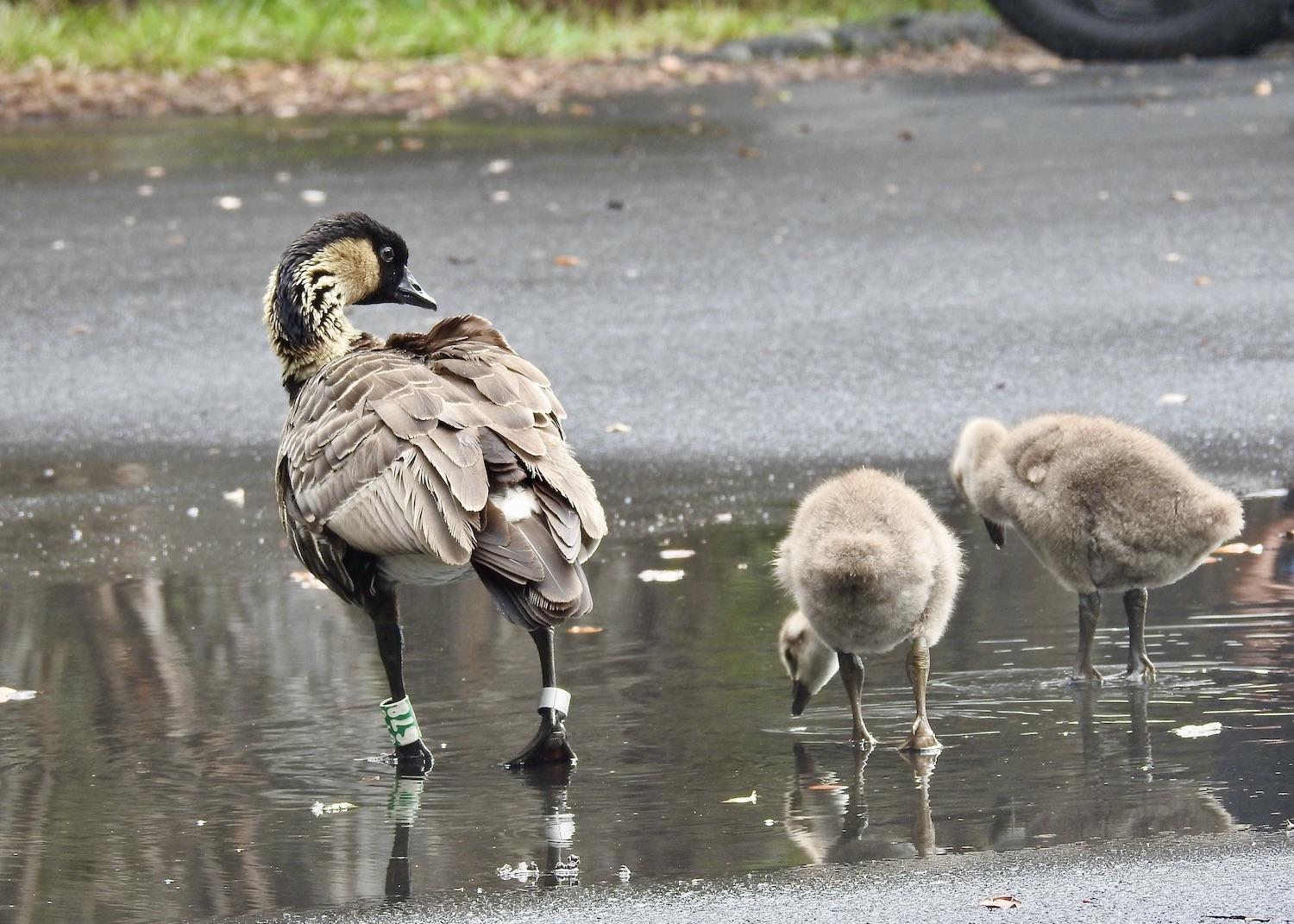
A rear view of three members of a nēnē family in a parking lot puddle/Jennifer Bain
It was almost lunchtime on February 4 when I finally saw the nēnē family in the parking lot, not long after they lost that third gosling and established a travel route between Puʻupuaʻi and Devastation to the first trailhead at the intersection of Chain of Craters Road. For 12 precarious minutes, according to time stamps on my photos, the geese meandered around the lot before disappearing into the forest.
Several weeks later, the geese moved lower down Chain of Craters Road where vehicles travel at faster speeds and they were in even more danger of being hit and killed. Park staff captured the family and relocated them within a 13-acre, cat-proof nēnē pen. Goslings are usually banded when they're 10 to 12 weeks old, so by now those two I watched forage in puddles have probably been given small U.S. Fish & Wildlife Service silver bands on one leg and plastic green bands with white letters on the other.
Some day soon, they’ll be released back into the wild.
“It takes all of us to help nēnē survive and every visitor is invited to be the part of the success story in saving nēnē from the brink of extinction by doing these three things,” Forbes-Perry and McDaniel said, driving home the park's key message one last time. “Keep wildlife wild and give them space, even if they come to you (60 feet). Never, ever feed nēnē. Drive the speed limit and watch for nēnē on roadways.”


